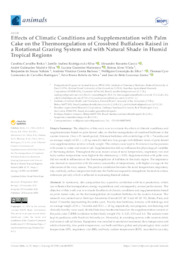Effects of climatic conditions and supplementation with palm cake on the thermoregulation of crossbred buffaloes raised in a rotational grazing system and with natural shade in humid tropical regions.
Effects of climatic conditions and supplementation with palm cake on the thermoregulation of crossbred buffaloes raised in a rotational grazing system and with natural shade in humid tropical regions.
Author(s): BRCKO, C. C.; SILVA, J. A. R. DA; GARCIA, A. R.; SILVA, A. G. M. E; MARTORANO, L. G.; VILELA, R. A.; NAHÚM, B. DE S.; BARBOSA, A. V. C.; SILVA, W. C. DA; RODRIGUES, T. C. G. DE C.; SILVA, E. B. R. DA; LOURENÇO JÚNIOR, J. DE B.
Summary: In ruminants, diet composition has a positive correlation with heat production, which can influence thermoregulation, energy expenditure and, consequently, animal performance. The objective of this work was to evaluate the effects of climatic conditions and supplementation based on palm kernel cake, on the thermoregulation of crossbred buffaloes in the eastern Amazon. The research was carried out at Embrapa Amazônia Oriental (01°26? S and 48°24? W), Belém, Pará, and lasted 12 months (representing the entire year). Twenty-four buffaloes, females, with initial age and an average weight of 54 ± 7 months and 503.1 ± 23 kg, respectively, non-pregnant, non-lactating and clinically healthy were used, divided into four treatments based on the supplementation content of the palm cake (%DM) in relation to their body weight (%): 0, 0.25, 0.50 and 1.0. The animals were kept in paddocks with Brachiaria brizantha (cv. Marandu), in a rotating system, with water to drink and mineral salt ad libitum. Equipment was installed to record environmental data (temperature and relative humidity, dew point temperature, wet bulb and black globe) and physiological data: rectal temperature (RT); respiratory rate (RR); and body surface temperature (BST), recorded twice a day, always in the morning (6:00 a.m. to 7:00 a.m.) and afternoon (12:00 p.m. to 1:00 p.m.) shifts, and were used to calculate the Globe Temperature and Humidity Index (GTHI). Supplementation did not influence the physiological variables of thermoregulation (p > 0.05). However, there were differences in the GTHI between the shifts, with higher means in the afternoon shift, especially in the less rainy period of the year, where the GTHI reached 92.06 ± 2.74 (p < 0.05). In all periods of the year, the mean values of RT, RR and BST were higher in the afternoon shift (p > 0.05). The respiratory rate (RR) is associated with the annual seasonality of the thermal waters, with higher averages in the afternoons of the rainy season. The positive correlation for rectal temperature, respiratory rate and body surface temperature indicated that buffaloes respond to thermal elevations in the atmosphere (afternoon period) and, consequently, reflect on the GTHI. Supplementation does not influence thermoregulation; the changes observed occurred in response to the region’s thermal and rainfall conditions (mainly in the afternoon shift), with higher GTHI values.
Publication year: 2024
Types of publication: Journal article
Observation
Some of Embrapa's publications are published as ePub files. To read them, use or download one of the following free software options to your computer or mobile device. Android: Google Play Books; IOS: iBooks; Windows and Linux: Calibre.
Access other publications
Access the Agricultural Research Database (BDPA) to consult Embrapa's full library collection and records.
Visit Embrapa Bookstore to purchase books and other publications sold by Embrapa.

